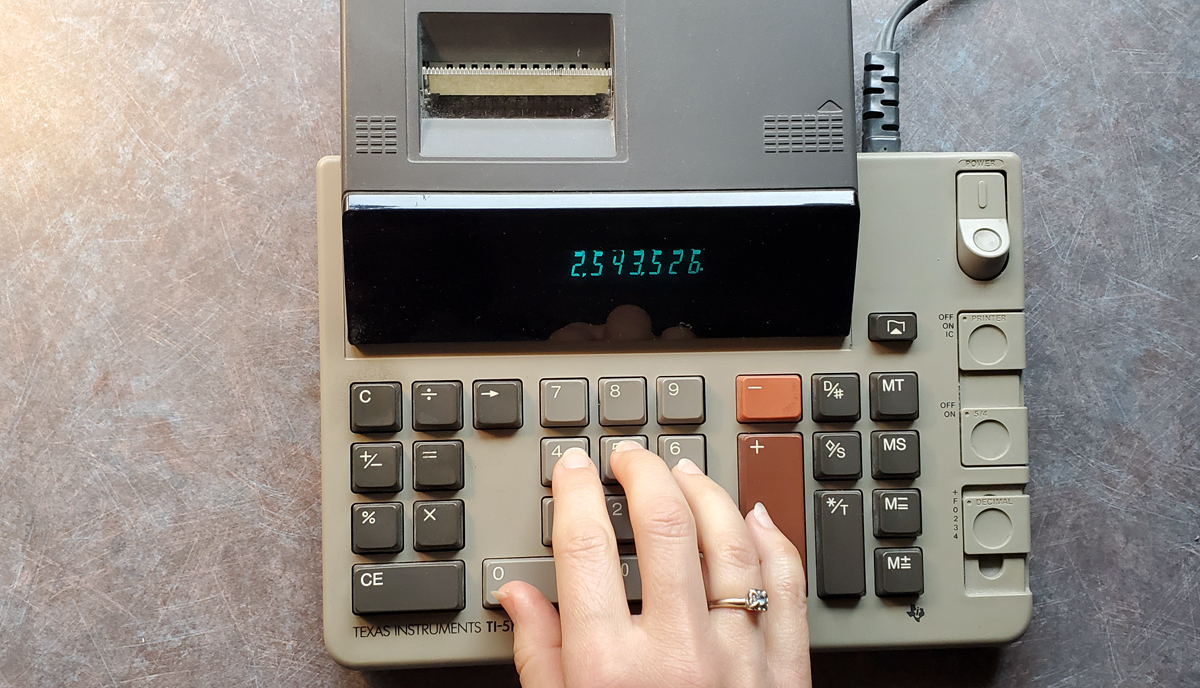Most people who are saving for retirement are familiar with the 4% rule. According to this rule, proposed by William P. Bengen in 1994, and later confirmed by Trinity University in 1998, you can withdraw 4% of your retirement assets the first year of retirement and then increase your withdrawal for inflation each year thereafter. By following this rule, you will have nearly a 100% probability that your retirement funds will not run out over the next 30 years.
Ever since this 4% rule was proposed, people have argued whether the “right” number is a little lower or higher than 4%. But nearly every time I see this rule used to reverse engineer the amount one needs to save for retirement, the calculation is done incorrectly. Because of this miscalculation, that almost everyone on social media is making, the amount of money that needs to be saved before retirement is under estimated. I fear this error is going to cause many people to retire with not enough saved to last the rest of their lives as they try to cut the amount they have saved as close as possible in order to retire as early as possible. Let me explain how to calculate the amount you need to save before retirement correctly.
The error I see perpetuated is in how the 4% rule is used to reverse engineer the amount one needs for retirement and sounds something like this: If you can safely withdraw 4% of your retirement balance annually, and that amount will meet your retirement expenses, then you need to save 25 times your annual expenses to be financially ready to retire. At a quick glance, that seems to make sense. But in practical usage it falls short. I noticed this after I was actually living off my retirement savings.
If my projected retirement expenses are $100,000 a year, then this reverse engineering would mean I need a nest egg of 25 times that or $2,500,000 to retire. Then when I take my 4% of the $2,500,000 I have saved, I would be able to withdraw $100,000 a year to meet my expenses. The big error is in not accounting for taxes.
When I take the $100,000 out as my 4% distribution, I will have to pay taxes on the withdrawn amount. In my third year of early retirement, my effective tax rate was 15.6% federal and 8.6% state for a total of 24.2% combined income taxes. That means my $100,000 withdrawal becomes $75,800 after taxes. That will fall quite a bit short of covering my expenses.
Everyone will have a different tax situation as taxes differ among states and types of investments. In my case, I live in Oregon and all of my retirement distributions are taxable. I do not have any Roth products. My retirement money is invested in a traditional IRA, 401(k), and deferred compensation. This means I will be paying taxes with each withdrawal.
If one had most of their money in Roth products and standard taxable brokerage accounts, then their tax burden will be less, but not zero.
Forgetting to take taxes into account is a fatal flaw in most recommendations. In my case, if I had not taken taxes into account and simply multiplied my living expenses by 25 to get my retirement savings target, I would have retired and had to start making major cuts in my living expenses. That would have made me very upset about the timing of my early retirement.
There are two ways one can take taxes into consideration. The first is to add in the projected tax bill to the projected retirement expenses. In my case, I would add the $24,200 estimated tax bill to my living expenses. Then the money needed for me to live on would no longer be $100,000, it would increase to $124,200. I also need to factor in the additional tax due on the extra $24,200 I took out. Multiplying this additional money by 24.2% adds another $5,854 to the needed withdrawal. That makes the total needed $124,200 + $5,854 = $130,054. Then I could multiply the total amount needed by 25 to get the minimum nest egg I could retire on. This new number is $3,251,350. This is an increase of $751,350 over the previous calculation.
In order to safely retire, I need to work longer to save that extra $751,350. The corrected calculation stops me from retiring too early and ending up needing to scrimp or decrease my retirement expenses because my savings was insufficient due to miscalculating the amount I needed to save before I retired.
The second method involves accounting for the taxes in the 25x multiplier. In my case, taxes will reduce my available money by about 25% of what I withdraw. That means if I withdraw the safe 4% of my account each year, only 3% of the money will be available for me to spend and the other 1% of the money I take out will go to taxes.
So now I know that 3% of the 4% withdrawn from my portfolio will be spent on my living expenses. Reverse engineering my retirement number means I need to save 33 times (100/3) my projected living expenses in order to take the safe 4% withdrawal and have enough to pay the taxes and live on.
Taking my living expenses of $100,000 and multiplying it by 33 gives me a target retirement amount of $3,300,000. So, with this calculation I need to save $800,000 over the original 25x multiplier.
Both methods show that multiplying my projected retirement expenses by 25 underestimates my retirement needs by about $800,000. That is a pretty big miscalculation if I forget to include taxes.
Using the first method, I save up $3,251,350 and take a 4% withdrawal of $130,054. I pay my 24.2% taxes which is $31,473 and I have $98,581 left over to live on. A much closer estimate than before.
In the second method, I save up $3,300,000 and take a 4% withdrawal of $132,000. I pay my 24.2% taxes of $31,944 leaving me with $100,056 to live on which is just over my estimated living expenses.
Both methods arrive very close to my projected retirement income need. As you can see, leaving out the tax effect can be devastating to your retirement years.
All of these calculations assume you are only living off your portfolio income, which is often not the case. Any additional income you have, such as real estate cash flow, or social security is subtracted from your living expense need. For example, if I had $50,000 of real estate cash flow after taxes, I could remove that amount from my projected retirement expenses. In the first example, I calculated that my before tax need was $130,054. If I subtract the after tax real estate cash flow of $50,000 from that number, I get a remaining need of $80,054. Multiplying that by 25 gives $2,001,350 needed in my nest egg.
The net real estate cash flow of $50,000 reduces my retirement account needs from $3,251,350, to $2,001,350. This big reduction, $1,250,000, means I can retire a whole lot sooner with additional cash flow coming in beyond my retirement savings.
Please take into account your taxes and any additional income you might have before you calculate your retirement savings need. This will keep you from making a common mistake that could hurt your retirement happiness. Also before you retire, read my book The Doctors Guide to Smart Career Alternative and Retirement so you can avoid other common mistakes.






A very good point that taxes do matter quite a bit. This is especially true because for Boomers like me the majority of my portfolio is in an IRA, not a ROTH. ROTH’s were not available for most of my accumulation years and conversion strategies were not practical when I was in the top tax brackets as a corporate executive.
However many people seem to also ignore Social Security in their estimates, which for many people will be much higher than their taxes. In our case when we take Social Security at age 70 my wife and I will draw over $70,000 a year in benefits. 85% of that will be taxable but it will still cover over half of our living costs. Even if that benefit was cut in half some day it would still more than offset our taxes. I think most people will have two withdrawal rates, an initial one before they start taking Social Security and then a much lower one when it kicks in. We’ll be withdrawing less than 1% of our portfolio when we start taking Social Security.
The other thing people ignore, and this is very risky, is inflation. If you are looking to retire in twenty years and you think your expenses are going to be $60,000 based on today’s dollars, you don’t need a target of 25*60= $1.5Million. You need an inflation adjusted target of over $3.6Million if we see an average inflation rate of 3% over the next twenty years. Because twenty years of 3% inflation will escalate the cost of living by 140%
Interesting, unless your retirement is a Roth 401(k) and then your contributions are after tax, correct? So, your distributions are tax free at the federal level.
Dividend Power, you are correct. If you have Roth products, they will distribute tax free. Many people don’t have them, like me. What ever products you have, be sure you account for the taxes involved.
Cory,
A recent blogger recently stated he felt the 4% rule is outdated. With rates being as low as they are, he believes the new 4% rule is more like .50%.
He is being extremely conservative and wants to leave an inheritance. Even without the inheritance, he suggests approximately a 1.5%-2% swr.
What are your thoughts on if the 4% rule is no longer a good barometer of a SWR.
CD, I think the 4% rule is just fine. It is for 30 years, not just this year. It already takes into consideration that interest rates and stock returns will fluctuate. I have been taking 4% out of my retirement plans every year and my balance is higher now than when I started taking in out three years ago. By my calculations, the 4% rule is too low, not too high. This is not theoretical, but my actual account balances.
Cory,
Excellent comments. I am always dumbfounded when taxes are not considered.
It is important to consider the percentage of savings in tax deferred vehicles.
A million dollars in an IRA is worth much less than a million dollars in a regular investment account. The IRA withdrawals are taxed as ordinary income while the investment account withdrawals ( profits only) are taxed as capital gains for now. Return of original investment is not taxed at all.
Dr. Joe, Great points. Thanks for the comments.
Why did you use the marginal tax rate instead of the effective tax rate for your calculations?
PharmMedMD I did not use marginal tax rate. I use my actual effective tax rate from my 2019 taxes, which I stated in the article. I had to pick some number for reference and what better number to use than my actual tax return from my third year retired. No guessing, no estimating, it was right off my actual tax return. Everyone will have a different marginal rate, but we have to start somewhere to make the calculations. Thanks for your question.
Nice article. That is usually glossed over or missed when trying to compute their FI number. (I missed it myself for my own initial calculations….fortunately I caught it later on)
Another item that is often missed is that the definition of ‘success’ in the 4% rule is very low. If on the 30th year you finished that year with $1 left it’s considered a success. However realistically most (maybe all) of us would not be able to live that. If you put in something more realistic (eg success = finish with a minimum level 20% of original sum) this will drop the 4% number to roughly ~3.75%. The larger the minimum level that you are comfortable with the larger the drop from the 4% point
great post! yes, definitely have to take taxes into consideration as part of expenses! I myself actually don’t use social security income in calculating my necessary nest egg, and assume this income will cover the tax bill. So I still use the 4% rule.
I plan retire at 65, to spend $100k in today’s dollars in retirement and take SS at age 70 to maximize the benefit. This presents a couple of problems then given years 66-69 I don’t have SS yet to cover my tax bill as well not sure if SS in the future will cover the tax bill. Wish I had a crystal ball!
btw Cory, did you every consider geoarbitrage as part of your retirement plan? Washington/Nevada are right next to you!
Rikki,
Yes we have considered geoarbitrage. Oregon has a 9% state income tax. Nevada and Washington have zero. Saving 9% on my expenses will not make my life better than it is since I already have more than I need. But moving away from my kids will make life worse. I might spend that saved 9% on travel to come visit my kids and future grandkids. It is not worth considering unless the overall impact is very positive. For me it is not. In addition my parents and Carolyn’s parents live in Oregon. In fact when I retired from medicine, we considered where to live as we could live anywhere. We couldn’t find a place better than where we were. So we are currently building a house to downsize and spend the rest of our lives in, just about a half mile away from our current home. When we considered moving, we decided to wait and see where our kids settled and make the decision then. They both settled here in town with us.
So how are you filing?
Federal tax amount you calculate would seem to be for a single person (or MFS) instead of MFJ.
Versus the figure I got by plugging in $100,000 income into the income tax estimator on Oregon’s website (calculates state & federal income taxes as well as payroll taxes)
http://www.tax-rates.org/income-tax-calculator/?action=preload
Bill in NC that was my actual tax rate on my entire tax return, which was not exactly $100,000 and includes other income besides my IRA distribution and provides a real life example, not theoretical. Everyone’s actual return and actual tax rate will be different. It doesn’t matter what tax rate you use as an example, if you do not account for the taxes you will pay, the number you calculate you will need for retirement will fall short.
But your post revolves around an annual, theoretical $100,000 withdrawal:
“If my projected retirement expenses are $100,000 a year…When I take the $100,000 out as my 4% distribution, I will have to pay taxes on the withdrawn amount. In my third year of early retirement, my effective tax rate was 15.6% federal and 8.6% state for a total of 24.2% combined income taxes. That means my $100,000 withdrawal becomes $75,800 after taxes.”
But MFJ, $100,000 in ordinary income results in only ~$8,600 in federal taxes…8.6% instead of 15.6%
Bill, you seem to be perseverating on how to calculate theoretical taxes. Your calculations make my point and confirm that, if you forget to include taxes, the withdrawal number still falls short of paying your expenses. You don’t want to fall short of meeting your needs after you retire. This article is not about how to calculate taxes. The point of the article is for you to remember to calculate YOUR estimated taxes in YOUR situation. Everyone will have a different situation based on their state taxes, number of dependents, deductions they claim, and source of income being taxable or tax free distributions. Figure out the number in YOUR situation and take that into account when you are trying to estimate how much money you will need to save in order to retire using the 4% rule to establish your distributions.
https://www.whitecoatinvestor.com/taxes-in-early-retirement/
https://www.whitecoatinvestor.com/0-income-tax-retirement/
Todd,
Those are two good articles on how we can minimize the amount of income tax we will pay in retirement: One from Physician on FIRE and one from White Coat Investor. Thanks for contributing to the conversation.
Thanks,
I meant to include a comment that there is a strong argument to not be OVERLY concerned with taxes in retirement, especially if one has sizable taxable accounts and Roth buckets.
Early on when I was trying to figure out how much I needed to retire I would put in twice my spending into calculators to see what I came up with. I figured this would account for any tax increase or health care inflation.
Hatton,
That sounds like a good conservative way to be sure you will have enough.
I mistakenly assume that when people consider what their retirement spending will be, they account for taxes as part of that annual spend. But I’m probably giving too much credit in some instances.
I’m fortunate in that less than 20% of our assets are in tax-deferred investments, and I’ll be depleting some of them in the next five years or so as I deplete our non-governmental 457(b).
Cheers!
-PoF
You have failed to mention an alternate source of tax-free retirement income which a Universal Indexed Life Insurance contract. Applicable software can compare this investment to a 401k or other qualified plan choice. The trick is to take into consideration the administrative expenses of a life insurance contract and likely returns along with pre and post-retirement income tax rates.
Premium financed life insurance is even more effective as you are using bank money to finance your retirement. One has to be able to judge and account for the effect if both Depression Era returns and/or high interest rates as experience during the ’80’s.
The need for a professional with proper software for ‘comparison’ shopping and resources for borrowing are extremely important.
Horace,
I advise people to never buy life insurance that is also an “investment.” So I would not have mentioned doing that in any article.
That’s a great point that I see overlooked routinely.
Younger doctors seem to think “tax-deferred” means “tax-free.” They focus on putting money into retirement plans without planning a withdrawal strategy.
I wouldn’t be surprised if future income taxes are much higher so this may become even worse.
Even now if your state tax is 6% and your Fed is 24% that’s 30% to the government.
I sometimes ask doctors how much the would need to support that level of spending. They all underestimate the nest egg.
Even when I tell them to consider the tax. They might think they need $120 K or maybe $150K pretax. The actual number is more like $171K. ($120K / (1- tax))
That requires over $4M with a 4% withdrawal and over $5M with a 3% withdrawal. Physician overspending haunts us.